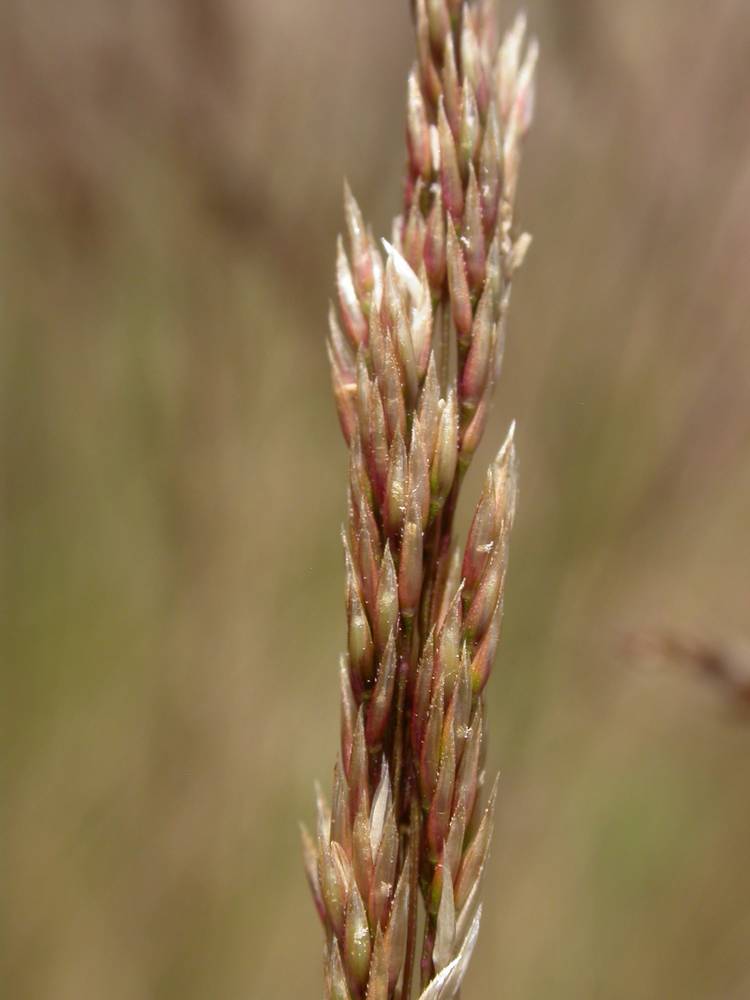Agrostis densiflora
Agrostis oregonensis
California bentgrass
Oregon redtop
ligules 1–3(7.5)mm; dorsal surfaces scabrous, membranous;
blades 2–12 cm × 2–10 mm; flat; upper blades wider than lower blades.
ligules 1.2–6.3 mm, truncate to rounded; erose-lacerate;
blades 10–30 cm × (1)2–5 mm; flat.
2–10 × 0.5– 2 cm; narrow; dense; ellow-green, sometimes tinged with purple, bases often enclosed in the upper sheaths at maturity;
branches appressed; to 1.5 cm, mostly hidden by the spikelets.
8–35(70) × (1.5)2.5–20 cm, usually 3 times longer than wide; open; lowest node with 1–15 branches, usually dark red or purple;
branches ascending;
spikelets somewhat clustered toward the branch tips; lower branches 2–10 cm;
primary branches branched above mid-length.
2–3.3 mm, 1-veined, densely scabrous over the back, strongly scabrous on the veins;
tips narrowly acute to acuminate or mucronate.
2–3.6 mm, 1(3)-veined, scabrous on the midvein, occasionally minutely scabrous over the body; acute to acuminate.
hairs to 0.3 mm; the hairs usually dense.
with sparse hairs to 0.2 mm.
1.5–2.1 mm; (3)5-veined;
veins extended as teeth to 0.3 mm;
tips acute to obtuse, sometimes toothed; awnless or awned;
lemma awns 0–3.5 mm, arising from above mid-length; straight, readily falling off.
1.5–2.5 mm, usually smooth, sometimes minutely scabrous or pubescent, 5-veined;
veins sometimes extended into teeth to 0.4 mm;
tips acute to obtuse, usually entire to toothed, usually awnless but sometimes with awned and awnless spikelets on the same plant;
lemma awns 0–2 mm, arising from about mid-length; straight (rarely bent), not exserted.
(0.3)0.5–0.7 mm.
absent or to 0.2 mm and thin.
0.3–0.7 mm.
0.5–1.2 mm.
=42.
Agrostis densiflora
Agrostis oregonensis
Sandy soils on coastal dunes and bluffs. 0–50 m. Est. CA. Native.
With its dense inflorescence, A. densiflora can be confused with A. exarata and coastal forms of A. pallens. Agrostis exarata usually has shorter paleas and longer ligules, although there is considerable overlap in these characters. Agrostis pallens is usually strongly rhizomatous, its anthers are more than 1 mm, its inflorescence is exserted from the upper leaf sheaths, and it usually has narrower leaves.
Lakeshores, streamsides and wet meadows, sometimes with sphagnum. 0–2300m. Casc, ECas, Est, Sisk, WV. CA, ID, NV, WA; north to British Columbia, east to WY. Native.
Agrostis oregonensis has an open, dark reddish panicle with primary branches not branched or spikelet-bearing on the lower half. Agrostis scabra has narrower leaves and an even more open, diffuse panicle that breaks off at the base and rolls away like a tumbleweed.
Barbara Wilson, Richard Brainerd, Nick Otting
Barbara Wilson, Richard Brainerd, Nick Otting
- Local floras:
BC,
CA,
OR,
WA
- Local Web sites:
CalFlora,
CalPhotos,
Flora NW,
PNW Herbaria
WildflowerSearch
iNaturalist (observations)
USDA Plants Database
- LBJ Wildflower Center
- SEINet
- Plants of the World Online
- Encyclopedia of Life
- Wikipedia
- Google Image Search





